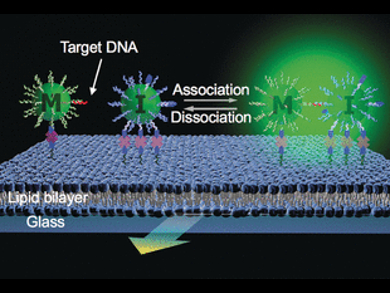DNA Quantification by Light Scattering
Traces of biomolecules such as DNA can be detected with a new “dynamic” technique based on the observation of association and dissociation events of gold nanoparticles. If the desired DNA sequence is present, it can reversibly bind two nanoparticles together. This can be detected in real time through a change in light scattering. As reported in the journal Angewandte Chemie, this method differentiates true signals from noise and can detect deviations of individual bases.
Detecting and quantifying biomolecules at extremely small concentrations is increasingly important for applications such as early and precise diagnosis, monitoring cancer treatment, forensic investigations, and highly sensitive tests for biological weapons. The current method of choice is the polymerase chain reaction (PCR), which is based on the enzymatic replication of DNA. The disadvantage of this method is the false positives that may result from the tiniest amounts of impurity.
Association and Dissociation of Gold Nanoparticles
Scientists working with Jwa-Min Nam at Seoul National University (South Korea) have now developed a new method for detecting extremely small amounts of DNA—without replication, signal amplification, or false positive results. Their method is based on the detection of individual binding events. Because the binding partners continuously separate and then bind again, the number of detectable results is multiplied and unspecific signals are minimized. This associating and dissociating nanodimer analysis (ADNA) is based on the measurement of light scattering by gold nanoparticles using dark-field microscopy.
The sample and two types of gold nanoparticles are placed onto a glass slide coated with a lipid double layer. One type of nanoparticle has binding sites on the surface that anchor to the lipid layer. The other type reversibly binds to the lipid layer, remaining mobile. Both nanoparticles have short single-stranded DNA segments that are complementary to two different sequences in the target DNA so that they can bind it. When a mobile nanoparticle comes very close to an immobilized one, the target DNA can bind them into a dimer.
Detecting Ultra-Low Concentrations
When two nanoparticles are bound, their vibrations (plasmons) are coupled. This changes the intensity and color of scattered light, which can be detected in real time. The dynamic analysis of dimers that dissociated during observation is the key to the clear differentiation between the presence and absence of the target DNA. The kinetics of the dissociation are significantly different for DNA that is a perfect match and DNA with a single altered base.
Even in the presence of other DNA, such as in a sample of human blood serum, it was possible to selectively detect and reliably quantify ultra-low concentrations of the target DNA. Under the test conditions used, the detection limit was about 46 DNA copies.
- Associating and Dissociating Nanodimer Analysis for Quantifying Ultrasmall Amounts of DNA,
Keunsuk Kim, Jeong-Wook Oh, Young Kwang Lee, Jiwoong Son, Jwa-Min Nam,
Angew. Chem. Int. Ed. 2017.
DOI: 10.1002/anie.201705330



